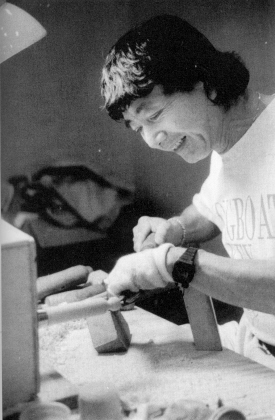
Koma Zuru makes tops at the IJA's 49th Annual Festival (Bill Giduz photo) |
Top Master Koma Zuru performs the sideways spinning top at the IJA's 49th Annual Festival (Bill Giduz photo) |
Page 41 Fall 1996
|
by
Bill Giduz
He
spins tops that are smaller than his
He
came to the USA from his native Japan in 1960
as part of a 32-person show from Japan. Since then he has
toured the world many
times over, though his performing days may be numbered at this
point.
His
family has entertained in Japan for seven generations. Zuru began
performing as a dancer, and it shows in his graceful moves around the
stage now as he spins tops with his fingers, palms and string and
manipulates them on his palm, ropes, lanterns and fans.
He
makes all his tops, and set up a lathe in the
comer of the gym in Rapid City where he turned new ones all the time.
Those which he uses in his act are made from different types of
hardwood, and must be sanded and painted
He
makes tops with wooden tips, and professional models driven through
with a metal spike. The latter type can
As
a young man, he danced in shows on US military bases in Japan, and the
GIs he came to know inspired his dreams of coming to the USA. He made
his father happy by deciding he would have more success as a top
spinner than a dancer, and began learning the act. He first performed
it publicly during ceremonies for
the 1964 Olympics in Tokyo.
His
career was launched when Ed Sullivan saw his act shortly thereafter
during a trip to Japan. He invited Zuru to appear on his show and flew
him to Los Angeles for taping on Sept. 26, 1965. It was only the
second Ed Sullivan Show ever broadcast in color. He was invited back
for another show on Dec. 26, this time in New York. Those shows have
been perpetuated as one of the acts on the new "Best of
Sullivan" video, and Zuru happily accepts the pennies of
royalties he receives from each sale!
The
second appearance led to a six-week booking at Radio City Music Hall,
where he created larger props for the big stage. He ended up spending
four years in the USA, then went to West Germany to tape a TV show.
Like his appearance on the Ed Sullivan Show, that led to further
bookings that carried him through the next three years. Since then he
has performed all over the world, but he has been disappointed to
watch the market shrink during the past 15-20 years. Night clubs
But
he notes that there are now some new amateur top spinners in Japan,
and perhaps one of them will rise to take his place after he retires
soon. He said his future plans may include writing a book about top
spinning, and teaching young children. Their act is likely to be as
different from his as his was from his father's, however.
His
current act, which he performed in the Cascade of Stars show at Rapid
City, is about seven minutes long and uses eight different tops. He
presents his manipulations with a Ninja character and strong music
that have evolved a long way from the traditional Japanese act he
first performed, but Zuru says that's a natural result of more than
three decades of international travel. He concluded, "It's not an
act made in Japan anymore, it's an act created around the world." |

Koma Zuru makes tops at the IJA's 49th Annual Festival (Bill Giduz photo) |
Top Master Koma Zuru performs the sideways spinning top at the IJA's 49th Annual Festival (Bill Giduz photo) |